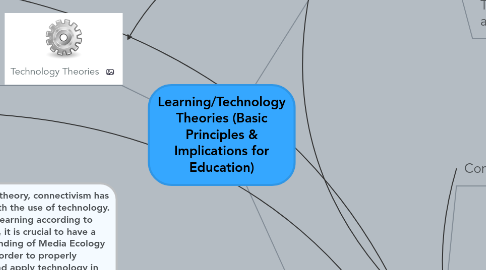
1. Technology Theories
1.1. SCOT (the Social Construction of Technology)
1.1.1. Basic Principles: A social constructivist theory about learning and technology that explains how human action shapes technology. In short, social constructivists hold that technology (and the use of technology) can only be understood in a human/social context.
1.1.2. Implications for Education: Students should come to firm understandings about the effective uses of technologies, keeping in mind that they are designed/developed to provide support in specific human activities.
1.2. Media Ecology
1.2.1. Basic Principles: The study of media as environments. It is concerned with the idea that technology, information, and communication shape and direct human affairs. Marshall McLuhan is largely responsible for the rise of Media Ecology (on account of his work during the 1950's and 60's).
1.2.2. Implications for Education: It is crucial for students to understand how media pervades all aspects of human life. Technology shapes human life just as humans shape technology.
2. As a learning theory, connectivism has a lot to do with the use of technology. For students learning according to this approach, it is crucial to have a firm understanding of Media Ecology and SCOT. In order to properly manipulate and apply technology in ways that are supportive of learning, students must understand how and why humans shape technology as well as how technology shapes and directs humans as a result.
3. Labelled as 'Combination Theories' for the representative purpose of this map, both TPACK and The Philosophy of Teachnology involve a tight-knit integration of Learning Theories and Technology Theories. Their holistic approaches to the interplay of Technology, Pedagogy, and Content (/Curriculum) bring a new-found oneness to (21st Century) educational theory and philosophy.
4. Though the philosophy of teachnology is not an accredited theory, it deals with the pervasive implication of technology upon both pedagogy and content/curriculum. This must be made clear when discussing teacher use of TPACK principles as well as personalized philosophies of teachnology, recognizing that both go hand-in-hand for teachers implementing technology in the classroom.
5. Combination Theories
5.1. The Philosophy of Teachnology
5.1.1. Basic Principles: Is primarily concerned with teaching students to investigate content and learn how to operate technological tools. These kinds of learned skills will be valuable for the entirety of a student's professional lifetime. As teachers develop their own personalized 'manifestos' of teachnology, they are increasingly able to implement innovative ways of teaching: 1) techno-literacy, 2) how to explore new kinds of information, and 3) how to attain an appropriate online voice/persona.
5.1.2. Implications for Education: Students will learn: 1) techno-literacy, 2) how to explore new kinds of information, and 3) how to attain an appropriate online voice/persona.
5.2. TPACK (Technology, Pedagogy, and Content Knowledge)
5.2.1. Basic Principles: TPACK outlines a tying-in of concepts, creating a conceptual trinity between Technology, Pedagogy, and Content Knowledge. In short, it identifies the knowledge needed by teachers when using technology to deliver content. Based on Shulman's PACK (Pedagogy and Content Knowledge), it is a theory retrofitted to the digital age of education.
5.2.2. Implications for Education: With TPACK as a durable framework for teaching w/ technology, teachers can facilitate learning in new and innovative ways that assure student learning and productivity. Teachers must stay firmly aligned to TPACK in order to balance tech-knowledge (TK), content knowledge (CK), and pedagogy knowledge (PK).
6. Learning Theories
6.1. Constructivism
6.1.1. Basic Principles: Promotes learning through the gradual construction of conceptual schemas. Asserts that individuals learn through making connections with their environment.
6.1.2. Implications for Education: Teacher may take new role as facilitator of learning (as opposed to instructor of learning). Involves the concept of 'scaffolding', implying that knowledge is constructed through the gradual fusing of new information to previously understood conceptual frameworks.
6.2. Cognitive Load Theory
6.2.1. Basic Principles: Asserts that working memory can only process so much information at a given time. In other words, the theory explains that working memory has a limited capacity and may experience overload if intake of information exceeds the limit.
6.2.2. Implications for Education: It is extremely important for teachers and students alike to be aware of the brain's cognitive capacity. Teachers should not force excessive amounts of information on students and students should adjust their study/learning habits to the limitations of working memory.
6.3. Connectivism
6.3.1. Basic Principles: Described as a 'network phenomenon'. It asserts that learning occurs when individuals take advantage of the learning opportunities offered by communication technologies. As the learning theory of the 'digital age', Connectivism prompts students to apply technology in effective and innovative ways that are supportive of learning.
6.3.2. Implications for Education: Central purpose is to promote the individual/personal development of students through their own exploration and discovery of communication technologies. With proper use of social networking tools and online communication, students can construct valuable networks of resources that are supportive of learning.
